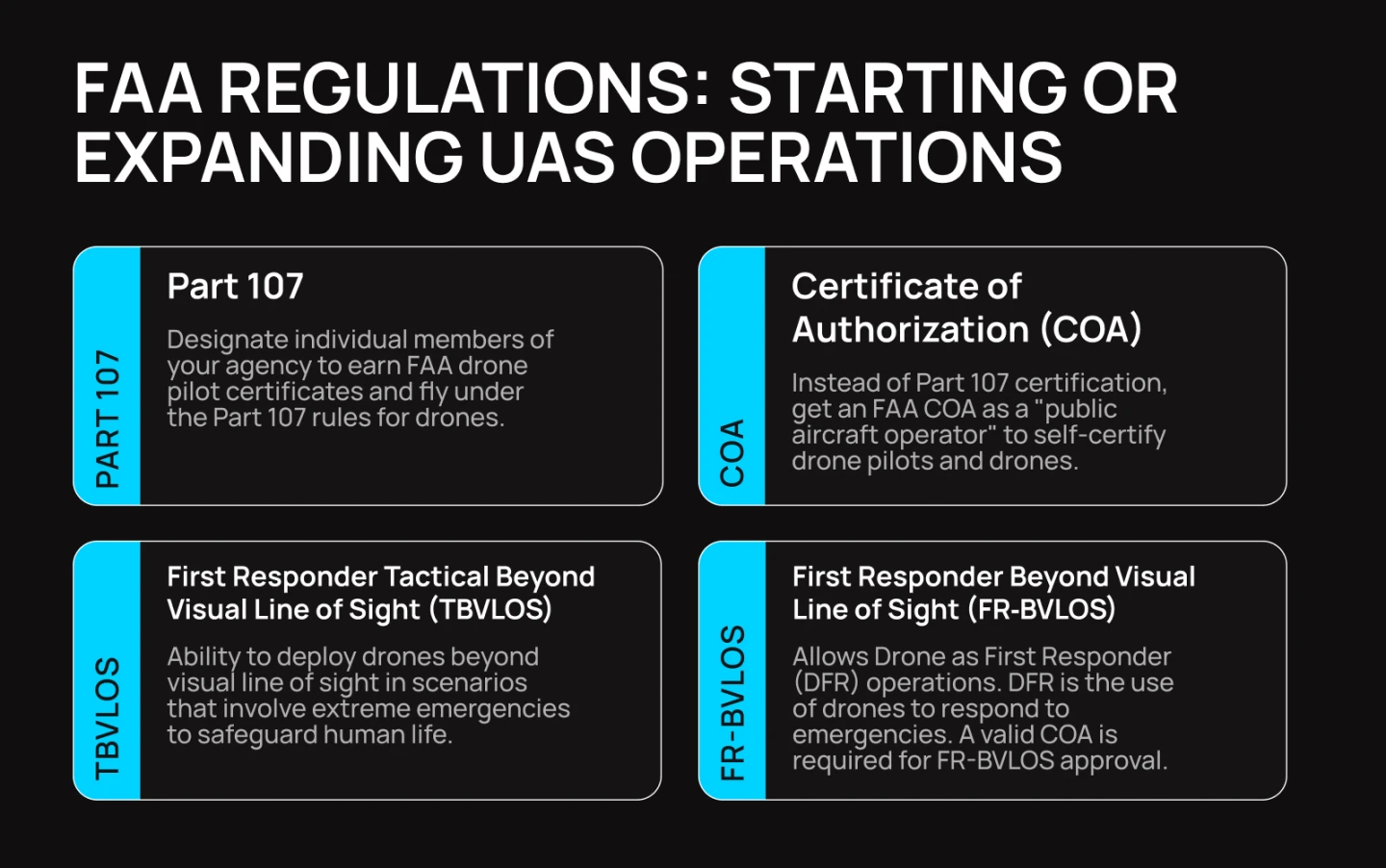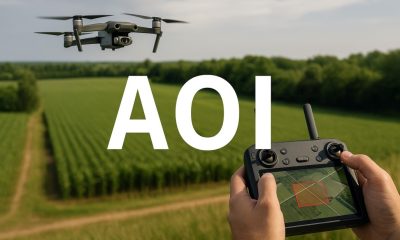- Acronym Guide
- AAM
- ABS
- AC
- ACAS
- ADS-B
- AFAC
- AGL
- AI
- AIM
- ALS
- AM
- AMA
- ANSP
- AOI
- APPI
- AUV
- AUVSI
- ARPAS-UK
- ASTM
- ATC
- BVLOS
- CAA
- CAAC
- CAB
- CASA
- CATT
- CBO
- CBR
- CBRN
- CDMA
- CDR
- CFR
- CIR
- COA
- COMINT
- CORS
- COTP
- COTR
- CPTED
- CV
- C2
- DAA
- DEM
- DFI
- DFS
- DGCA
- DHS
- DOD
- DPA
- DPEs
- DRG
- DRO
- DSM
- DSMX
- DSP
- DSSS
- DTM
- EASA
- EFT
- EO
- EOD
- EO/IR
- ELINT
- EMI
- ESC
- EVLOS
- eVTOLs
- FAA
- FCC
- FCS
- FHSS
- FICCI
- FLIR
- FOB
- FOV
- FPS
- FPV
- GBDAA
- GCP
- GCS
- GDPR
- GML
- GNSS
- GPS
- GSD
- GVC
- HDR
- HOGE
- IACRA
- ICAO
- ICS
- IMU
- INS
- IR
- ISA
- ISR
- ITU
- JARUS
- LAAMS
- LAANC
- LAATM
- LAI
- LBA
- LIDAR
- LOS
- LSALT
- MAC
- MAVLink
- MLIT
- MMS
- MSL
- MTOM
- NDAA
- NCSL
- NFZ
- NIST
- NMEA
- NOTAM
- NPA
- NPRM
- NTIA
- OBIA
- OEM
- OFDM
- OOP
- PASM
- PAV
- PCV
- PdM
- PEC
- PIC
- PID
- PIPL
- PLD
- PM
- PN
- PPK
- PPS
- PSM
- PWM
- UAM
- UAOP
- UAS
- UASTM
- UAV
- UCAVs
- UHD
- UHF
- USV
- UTM
- RAIM
- RCC
- RCS
- RFI
- ReOC
- RePL
- RMS
- ROI
- RPAS
- RPC
- RTH
- RTK
- SaR
- SAR
- SARP
- SBAS
- S.Bus
- SBIR
- SEDENA
- SfM
- SFOC
- SIGINT
- SLAM
- SMS
- SORA
- STANAG
- STTR
- sUAS
- TCAS
- TCCA
- TFR
- TIN
- TOF
- TP
- TPS
- TSA
- VHF
- VLOS
- VTOL
Drone Acronyms
What is COA (Certificate of Authorization) & How Does it Work?
By
Jacob StonerTable Of Contents

Definition
COA stands for Certificate of Authorization. It is a formal approval issued by aviation authorities, such as the Federal Aviation Administration (FAA) in the United States, that permits a specific drone operation or series of operations in controlled airspace.
Relevance to the Industry
The COA is crucial for expanding the scope of drone operations, allowing for more complex and mission-critical activities. It ensures that operators have met all necessary safety and regulatory standards, thus enhancing the safe integration of drones into the national airspace.
How Does a Certificate of Authorization (COA) Work?
A Certificate of Authorization (COA) is a formal approval issued by the Federal Aviation Administration (FAA) in the United States that allows specific unmanned aircraft systems (UAS) operations in the National Airspace System (NAS). COAs are typically granted to public entities, such as government agencies, law enforcement, and educational institutions, to conduct UAS missions for various purposes. Here’s a detailed explanation of how the COA process works:
1. Eligibility and Application
- Eligibility: COAs are generally available to public entities, including federal, state, and local government agencies, law enforcement, and educational institutions. Commercial entities usually apply for Part 107 waivers instead.
- Application Submission: The entity submits a COA application to the FAA, outlining the details of the proposed UAS operations. This includes the type of UAS, the intended use, the operational area, and the duration of the operation.
2. Application Requirements
- Operational Description: A detailed description of the UAS operations, including flight objectives, procedures, and safety measures.
- UAS Specifications: Information about the UAS, including its make, model, performance characteristics, and maintenance procedures.
- Safety and Risk Management: A comprehensive safety plan that addresses potential risks
and mitigation strategies to ensure safe operation within the National Airspace System (NAS).
- Pilot Qualifications: Details about the qualifications and training of the UAS operators, including certifications, experience, and any special training related to UAS operations.
- Airspace and Location: Information about the specific airspace and geographic area where the UAS operations will take place, including maps and coordinates.
- Emergency Procedures: Established protocols for handling emergencies, including communication procedures with air traffic control (ATC) and other relevant authorities.
3. FAA Review Process
- Initial Review: The FAA reviews the submitted application to ensure it meets all necessary requirements and contains sufficient detail about the proposed operations.
- Risk Assessment: The FAA conducts a risk assessment to evaluate the potential impact of the UAS operations on manned aircraft, people, and property on the ground.
- Coordination with ATC: If the proposed operations involve controlled airspace, the FAA coordinates with the appropriate ATC facilities to ensure safe integration with existing air traffic.
- Feedback and Revisions: The FAA may request additional information or revisions to the application to address any identified concerns or gaps in the proposal.
4. Issuance of the COA
- Approval: Once the FAA is satisfied that the proposed operations can be conducted safely, it issues a Certificate of Authorization (COA). The COA specifies the conditions and limitations under which the UAS operations can occur.
- Conditions and Limitations: The COA includes specific conditions and limitations to ensure safety, such as altitude restrictions, weather conditions, operating times, and communication requirements with ATC.
5. Operational Compliance
- Adherence to COA Conditions: The entity must strictly adhere to the conditions and limitations outlined in the COA during UAS operations. Any deviations from the approved plan must be communicated to the FAA and may require additional approval.
- Record Keeping and Reporting: The entity must maintain detailed records of UAS operations, including flight logs, maintenance records, and any incidents or accidents. Periodic reports to the FAA may also be required.
6. Renewal and Amendments
- Renewal Process: COAs are typically issued for a specific period, often up to one year. Entities must apply for renewal before the COA expires, providing updated information and demonstrating continued compliance with safety standards.
- Amendments: If operational changes are needed, such as new operating locations or updated UAS specifications, the entity must apply for an amendment to the existing COA. The amendment process involves a similar review and approval process as the initial application.
7. Applications and Use Cases
- Public Safety and Law Enforcement: COAs enable law enforcement agencies to use UAS for tasks such as search and rescue, surveillance, accident investigation, and crowd monitoring.
- Research and Education: Educational institutions and research organizations use COAs to conduct scientific research, environmental monitoring, and testing new UAS technologies.
- Infrastructure Inspection: Government agencies use UAS to inspect critical infrastructure, such as bridges, pipelines, and power lines, enhancing safety and efficiency.
- Disaster Response: UAS operations under COAs support disaster response and recovery efforts by providing aerial imagery, damage assessment, and situational awareness.
Example in Use
“The research team obtained a COA to conduct drone flights over the national park for wildlife monitoring, ensuring all operations were compliant with FAA regulations.”
Frequently Asked Questions about COA (Certificate of Authorization)
1. What is a COA and why is it needed for drone operations?
Answer: A COA (Certificate of Authorization) is an official approval from aviation authorities that permits specific drone operations in controlled or restricted airspace. It is needed to ensure that drone flights are conducted safely and in compliance with regulatory standards. This certificate is particularly important for operations that go beyond the standard rules, such as flying near airports, over populated areas, or beyond visual line of sight (BVLOS).
2. How can an operator obtain a COA?
Answer: To obtain a COA, an operator must:
- Submit an Application: Provide detailed information about the planned operations, including the purpose, location, duration, and safety measures.
- Demonstrate Compliance: Show that they have met all safety and regulatory requirements, including pilot certifications, drone specifications, and operational procedures.
- Undergo Review: The application is reviewed by the relevant aviation authority to ensure that the proposed operations can be conducted safely.
- Receive Approval: If the application meets all criteria, the COA is granted, allowing the operator to proceed with the planned drone operations.
3. What are the benefits of obtaining a COA for drone operations?
Answer: The benefits of obtaining a COA include:
- Expanded Operational Scope: Allows for more complex and extended drone operations that would otherwise be restricted.
- Regulatory Compliance: Ensures that all drone flights are conducted in accordance with aviation regulations, reducing the risk of legal issues.
- Enhanced Safety: Demonstrates that the operator has implemented the necessary safety measures to protect both the drone and other airspace users.
- Increased Credibility: Provides assurance to clients, partners, and regulatory bodies that the operator is qualified and authorized to conduct advanced drone operations.
For examples of these acronyms visit our Industries page.
As the CEO of Flyeye.io, Jacob Stoner spearheads the company's operations with his extensive expertise in the drone industry. He is a licensed commercial drone operator in Canada, where he frequently conducts drone inspections. Jacob is a highly respected figure within his local drone community, where he indulges his passion for videography during his leisure time. Above all, Jacob's keen interest lies in the potential societal impact of drone technology advancements.











